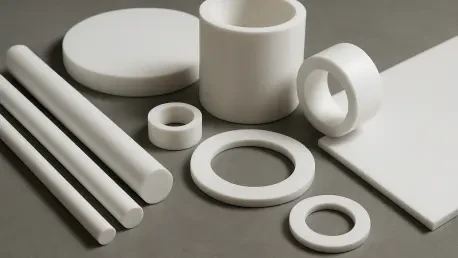The Polytetrafluoroethylene (PTFE) market stands at a pivotal moment, with projections indicating a robust climb from USD 3.4 billion in 2025 to USD 5.7 billion by 2034, driven by a compound annual growth rate (CAGR) of 6%. Renowned for its exceptional qualities such as chemical resistance, non-stick surfaces, and the ability to withstand high temperatures, PTFE—often associated with well-known trade names—has cemented its status as a critical material across a wide array of industries. From automotive to aerospace, electronics to medical applications, its versatility fuels demand in an era of rapid technological advancement. This article delves into the multifaceted factors propelling this market forward over the coming decade, examining key drivers, emerging opportunities, and the challenges that shape its trajectory. As global industries increasingly rely on high-performance materials, PTFE’s unique properties position it as a cornerstone of innovation, promising substantial growth amid evolving needs.
Beyond its inherent material strengths, PTFE’s relevance is amplified by its adaptability to cutting-edge applications that define modern progress. Industries are under constant pressure to innovate, seeking solutions that offer durability and efficiency under extreme conditions. PTFE meets these demands with unmatched reliability, whether in harsh chemical environments or high-stress mechanical systems. This adaptability ensures its place in both established and emerging sectors, making it a linchpin for future developments. The following sections explore how specific industries, environmental considerations, and technological advancements collectively contribute to the sustained expansion of this dynamic market.
Market Drivers and Industry Applications
Automotive and Electric Vehicle Boom
The automotive sector emerges as a powerhouse driving PTFE demand, particularly with the global shift toward electric vehicles (EVs). As governments and manufacturers prioritize sustainable transportation, EVs have become a focal point of innovation, requiring materials that enhance safety and efficiency. PTFE plays a crucial role in this transition, notably in battery separators that prevent short circuits and in thermal insulation that manages heat dissipation. These applications are vital for extending battery life and ensuring vehicle reliability, especially as EV adoption accelerates worldwide. The material’s ability to withstand the rigors of electric power systems positions it as an essential component, aligning with broader environmental goals and fueling market growth over the forecast period.
Moreover, PTFE’s utility extends beyond EVs to traditional automotive applications, where its low friction and durability are leveraged in gaskets, seals, and coatings. These components must endure high temperatures and corrosive fluids, conditions under which PTFE excels. As the automotive industry continues to evolve with stricter emission standards and a push for lightweight materials, the demand for such high-performance solutions grows. This trend is particularly evident in regions investing heavily in automotive innovation, where PTFE’s contributions to efficiency and longevity are increasingly valued. The intersection of traditional and emerging needs within this sector underscores the material’s versatility, ensuring a steady rise in its market presence through 2034.
Electronics and 5G Infrastructure Growth
In the electronics industry, PTFE’s dielectric properties make it indispensable for the rapid rollout of 5G infrastructure, a transformative technology reshaping global connectivity. High-frequency cables and printed circuit boards, critical for 5G networks, rely on PTFE for insulation that minimizes signal loss and maintains performance under demanding conditions. As countries race to implement next-generation communication systems, the need for reliable materials to support this infrastructure intensifies. PTFE’s ability to meet these technical requirements ensures its growing adoption, positioning it at the forefront of a sector poised for exponential expansion over the next decade.
Additionally, the broader electronics market, including consumer devices and industrial systems, benefits from PTFE’s thermal stability and chemical inertness. These characteristics protect sensitive components from environmental stressors, extending the lifespan of products in a highly competitive field. With the proliferation of smart devices and the Internet of Things (IoT), the demand for materials that can keep pace with miniaturization and performance needs is surging. PTFE’s role in enabling such advancements highlights its importance beyond 5G, cementing its status as a key enabler of technological progress. This sustained relevance across diverse electronic applications drives significant market momentum, reflecting the material’s alignment with digital transformation trends.
Medical Sector Opportunities
The medical field represents a vital growth avenue for PTFE, thanks to its biocompatibility and non-reactive nature, which make it ideal for a range of critical applications. Used in implantable devices such as vascular grafts and catheters, PTFE ensures compatibility with the human body, reducing risks of adverse reactions. Surgical instruments also benefit from its properties, as coatings that minimize friction and enhance precision during procedures. As the global population ages and healthcare demands rise, the reliance on advanced materials like PTFE for innovative medical solutions becomes increasingly pronounced, promising a steady upward trajectory for market share.
Furthermore, the push toward minimally invasive surgical techniques amplifies PTFE’s importance in the medical sector. These procedures require specialized tools and materials that can operate effectively in confined spaces while maintaining sterility and reliability. PTFE’s adaptability to such needs drives research into new applications, from drug delivery systems to tissue engineering scaffolds. This ongoing innovation aligns with broader trends in healthcare, where patient outcomes and procedural efficiency are paramount. The material’s expanding role in addressing these priorities underscores its potential to capture a significant portion of the market, particularly as medical technology continues to advance through 2034.
Environmental and Regulatory Challenges
Sustainability and Regulatory Pressures
Despite its many advantages, the PTFE industry grapples with significant environmental challenges tied to perfluorinated compounds (PFCs), which are integral to its production process. These substances, known for their persistence in the environment and potential health risks, have drawn intense scrutiny from regulatory bodies in regions like North America and the European Union. Stricter guidelines and compliance requirements have emerged, compelling manufacturers to rethink traditional methods. This regulatory landscape not only increases production costs but also pushes the industry toward sustainable practices, as stakeholders seek to balance environmental responsibility with operational viability over the forecast period.
In response to these pressures, sustainability has taken center stage, with companies investing heavily in eco-friendly alternatives and recycling initiatives for PTFE. The development of greener variants aims to reduce the environmental footprint while preserving the material’s performance benefits. Such efforts are not merely reactive but also strategic, opening new market segments for sustainable materials that appeal to environmentally conscious consumers and industries. This shift reflects a broader commitment to aligning with global sustainability goals, ensuring that the PTFE market remains competitive even as it navigates complex regulatory challenges. The focus on green innovation is poised to redefine industry standards in the years ahead.
Balancing Compliance with Market Growth
Navigating the regulatory landscape requires a delicate balance between compliance and maintaining market growth, a challenge that shapes strategic decisions for PTFE producers. Adapting to stringent standards often involves significant investment in research and development to create compliant materials without compromising quality. This process can strain resources, particularly for smaller players in the market, yet it is essential for long-term viability. The ability to meet these demands while continuing to supply high-performance solutions to industries like automotive and electronics is a critical determinant of success in an increasingly regulated environment.
Moreover, the global nature of the PTFE market adds another layer of complexity, as regulatory frameworks vary across regions, necessitating tailored approaches to compliance. In some areas, proactive policies encourage innovation through incentives for sustainable practices, while in others, punitive measures for non-compliance dominate. This disparity requires agility from market participants to adapt to diverse expectations without disrupting supply chains. The ongoing evolution of these regulations will likely intensify scrutiny on environmental impact, pushing the industry to prioritize transparency and accountability. Successfully managing these dynamics ensures that growth opportunities are not stifled by regulatory hurdles through 2034.
Innovation and Competitive Dynamics
Technological Advancements in PTFE
Innovation remains a cornerstone of the PTFE market’s evolution, with technological advancements like nanotechnology transforming the material’s capabilities. By integrating nanoscale enhancements, PTFE composites achieve superior mechanical strength and durability, expanding their suitability for high-stress environments such as aerospace and defense. Components like seals and bearings in aircraft must endure extreme conditions, and these improved formulations ensure reliability where failure is not an option. Such progress not only broadens the scope of applications but also reinforces PTFE’s position as a leader in high-performance materials through the forecast period.
Additionally, research into advanced manufacturing processes is optimizing PTFE production, reducing waste and enhancing efficiency. These improvements lower costs and address some environmental concerns by minimizing resource use during fabrication. The focus on tailoring PTFE properties for specific industry needs—whether through chemical modifications or hybrid materials—drives its adoption in niche markets. As technology continues to push boundaries, the material’s adaptability keeps it relevant in cutting-edge sectors, from renewable energy systems to next-generation industrial equipment. This relentless pursuit of innovation ensures that PTFE remains a dynamic force in the materials landscape, poised for sustained growth.
Competitive Market Landscape
The PTFE market is characterized by a highly competitive environment, where established players and emerging disruptors vie for dominance through innovation and strategic positioning. Factors such as raw material availability and pricing pressures shape market dynamics, compelling companies to differentiate their offerings. Major firms leverage economies of scale and extensive research capabilities to maintain an edge, while smaller entrants often focus on niche applications or sustainable solutions to carve out market share. This rivalry fosters a climate of continuous improvement, benefiting end-users with better products and driving overall industry advancement.
Geographic expansion and partnerships also play a pivotal role in shaping the competitive landscape, as companies seek to tap into high-growth regions and diversify their portfolios. Collaborations between manufacturers and end-use industries facilitate tailored solutions that address specific challenges, enhancing customer loyalty. Meanwhile, the push for technological superiority intensifies, with investments in R&D aimed at creating next-generation PTFE products that meet evolving demands. This competitive fervor ensures that the market remains vibrant and responsive to global trends, setting the stage for robust growth through 2034 as stakeholders navigate the interplay of innovation and market strategy.
Reflecting on Market Potential and Future Steps
Looking back, the journey of the PTFE market reveals a compelling narrative of growth and adaptation, with its value projected to rise from USD 3.4 billion at the start of 2025 to USD 5.7 billion by 2034. Industries like automotive, electronics, and medical have leaned heavily on PTFE’s unparalleled properties to meet the demands of transformative technologies such as electric vehicles and 5G networks. Environmental concerns surrounding perfluorinated compounds have posed substantial challenges, yet they also spurred a wave of innovation in sustainable practices that reshaped industry priorities. This period highlighted PTFE’s enduring relevance, even as it navigated a complex landscape of regulation and competition.
Moving forward, stakeholders must prioritize strategic investments in eco-friendly alternatives and advanced recycling methods to address lingering environmental concerns. Embracing cutting-edge technologies like nanotechnology can further enhance PTFE’s applicability, ensuring it meets the nuanced needs of high-performance sectors. Collaboration across the value chain will be essential to align with varying regional regulations and to capitalize on emerging markets. By fostering a culture of innovation and sustainability, the industry can unlock new growth avenues, ensuring that PTFE continues to play a pivotal role in shaping technological and industrial advancements in the years beyond 2034.









